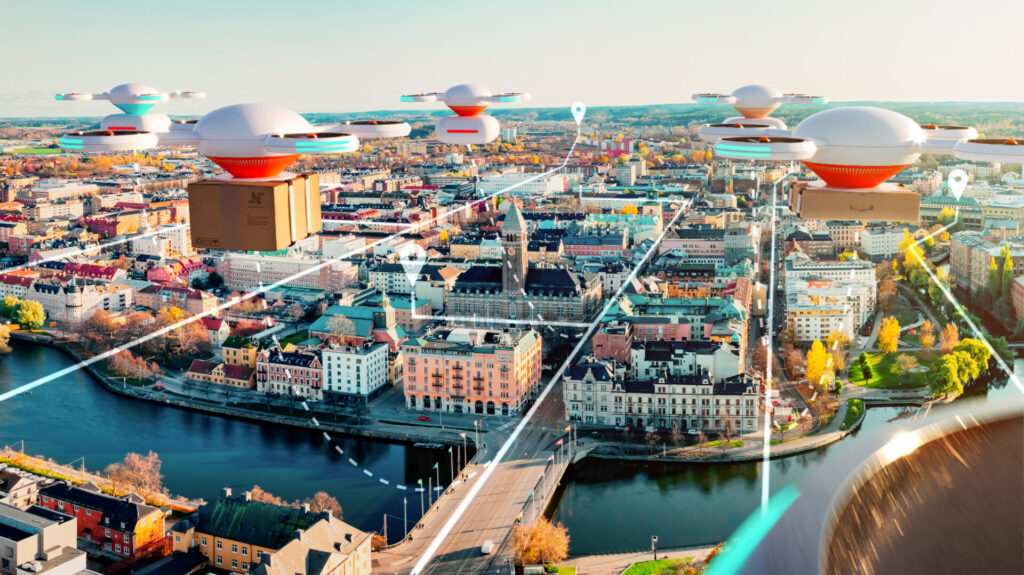Tomas Nylund, Chairman of the HIGS Research School Future-Proof Cities, was tasked by Aero EDIH to interview Victoria Barrsäter, Policy Expert in Transportföretagen (Aviation) at the Confederation of Swedish Enterprise. The purpose was to gain an understanding of the current state, future prospects, and the significance of drones for Sweden’s business sector.

Drones: A Growing Tool Across Industries
Victoria observes that drones are already being used professionally today at a rapidly increasing pace in many industries. A significant application area is inspection and data collection in sectors such as construction, real estate, agriculture, and forestry. Lightweight goods and food distribution is a growing sector, especially in archipelagos and rural municipalities. According to a survey conducted among members of the Swedish Drone Network, the use of drones for data collection and inspection in existing industries is expected to continue to grow significantly. By 2030, the largest growth is predicted to occur in freight transport, and by 2035, in passenger transport.
The Economic Importance and Use of Drones in Sweden
The global drone market generated SEK 254 billion in 2023, according to the Drone Insight Institute, and is projected to reach SEK 399 billion by 2026. These figures include both hardware and services.
In Sweden, there are currently about 800,000 drones. There are 31 organisations with specific permits for drone operations and 3 organisations with general permits for use within their respective activities. The police are currently one of the largest operators, with approximately 800 drones.
The Opportunities and Challenges of Drone Technology
Victoria Barrsäter highlights the rapid pace of technological development and the significant potential in leveraging the flexibility and environmental benefits that drones bring. In existing and established application areas, she points out advantages such as increased speed, cost efficiency, and higher quality in tasks involving data collection, measurement, and various types of inspections. Moreover, the use of drones often has significant workplace safety benefits, as they can replace high-risk activities such as inspecting building facades and roofs.
In a future scenario involving heavier drones capable of carrying both goods and passengers, a new mode of transport could emerge that is both fast and fossil-free through electrically powered vehicles. Unlike today’s land-based systems with roads and railways, such a mode of transport would not require extensive and costly infrastructure investments. For the business sector and Sweden’s competitiveness, this would be a major advantage. However, the necessary development of regulations, coordination between authorities, and planning for the transport system and infrastructure in Sweden is not keeping up with the pace of technological development. Victoria expresses concern that other countries are further ahead in this area. She points to a lack of resources and capacity among responsible authorities to investigate these issues as a contributing factor, noting that there are simply too few people currently able to focus on this.

Government Initiatives and Strategies for Unmanned Aviation
Transportstyrelsen, Sweden’s transport authority, has reported to the government with a study titled ”A Competitive Drone Industry in Sweden,” proposing the establishment of a national ambition for unmanned aviation in Sweden and the creation of a national platform for collaboration. Furthermore, the study calls for increased general knowledge about drones. Transportstyrelsen also sees the need to streamline the permit processes of government authorities.
Victoria also identifies the review and streamlining of permit processes as a critical factor for the further development of drones, particularly for large-scale transport. Additionally, technology needs to be established to enable digital visibility that includes both manned and unmanned air traffic, ensuring large-scale operations that are both safe and cost-effective.
Laws, Regulations and Resources: Barriers to Drone Technology Development
A significant obstacle to current and potential drone operations, such as data collection and inspection, is the Act on Dissemination Permits, which requires a lengthy processing time at Lantmäteriet (the Swedish mapping, cadastral, and land registration authority) that can take several months. This presents a frustrating barrier for many businesses. The law and its processing require reform.
Victoria also returns to the need for resources within the relevant authorities to advance the development of regulations, permit processes, and cooperation between involved authorities and stakeholders. She emphasises that the state must take responsibility for this. It is unreasonable to expect individual actors to shoulder responsibility for an issue of such national, long-term significance and scope as the establishment of a new mode of transport. Victoria notes that the drone sector currently consists of a group of dedicated and innovative start-ups. They cannot be expected to fund the national platform required in this case.
The Role of Municipalities in Development
When asked what municipalities need to do in planning to enable the development of a more efficient transport system that includes lower airspace, Victoria highlights the need for increased knowledge and forward-thinking about the opportunities and consequences for transport infrastructure planning. She cites Västerås and Örebro as examples of municipalities that have started addressing these issues. A suitable first step could be to consider which applications and uses of drones might be relevant within their own municipal operations. Victoria believes it is easier to start from familiar operations.















